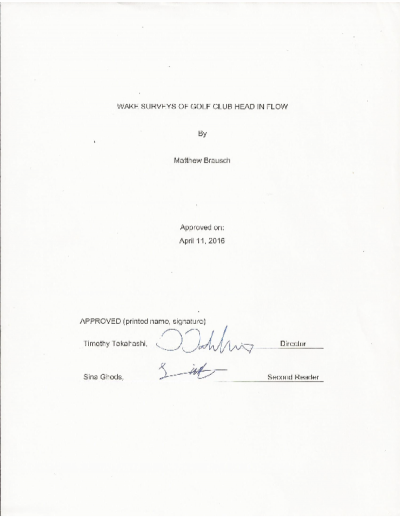Wake Survey of Bluff Bodies in Flow

Description
The aerodynamics of golf club heads effect the forces on the club head throughout the swing. The bluff body geometry and passive flow control elements make the aerodynamics of golf club heads far more complex. The theory behind the geometry of the bluff body aerodynamics relies on the state of the boundary layer and its interaction with the golf club head. Laminar and turbulent boundary layer flow result in drag, but in varying degrees. Separation, or attachment, of the boundary layer in these laminar and turbulent boundary layer flows is part of the cause of the induced drag. Skin friction and pressure drag are the two forms of surface forces which vary according to the state of the boundary layer. To review the state of the boundary layer flow and provide validation data for the corresponding, the golf club head was tested in a wind tunnel. Drag readings from the experiment showed the lowest drag occurred while the club face was perpendicular to the flow from the range of 50 miles per hour to 90 miles per hour. Additionally, the decrease in drag varied greatly depending on the orientation of golf club head. The decrease in the coefficient for the club perpendicular to the flow was approximately 3.99*〖10〗^(-6) C_d/Re while the decrease for the club at 110° was 1.07*〖10〗^(-6) C_d/Re. The general trend of the slopes indicated the pressure drag resulted in major variations while the drag due to skin friction remained relatively constant.
For the testing of the golf club head, two probes were developed to measure the turbulent intensity in the flow. The probes, based on Rossow’s (1993) three probe system, compared the dynamic pressure of the flow with the stream-wise dynamic pressure in the flow. The resultant measurements could then produce the ratio of the cross-stream fluctuations in velocity to the time-averaged velocity. The turbulence intensity calculations would provide insight on the turbulence in the boundary layer flow and wake.
For the testing of the golf club head, two probes were developed to measure the turbulent intensity in the flow. The probes, based on Rossow’s (1993) three probe system, compared the dynamic pressure of the flow with the stream-wise dynamic pressure in the flow. The resultant measurements could then produce the ratio of the cross-stream fluctuations in velocity to the time-averaged velocity. The turbulence intensity calculations would provide insight on the turbulence in the boundary layer flow and wake.
Date Created
The date the item was original created (prior to any relationship with the ASU Digital Repositories.)
2016-05
Agent
- Author (aut): Brausch, Matthew James
- Thesis director: Takahashi, Timothy
- Committee member: Ghods, Sina
- Contributor (ctb): Mechanical and Aerospace Engineering Program
- Contributor (ctb): Barrett, The Honors College
